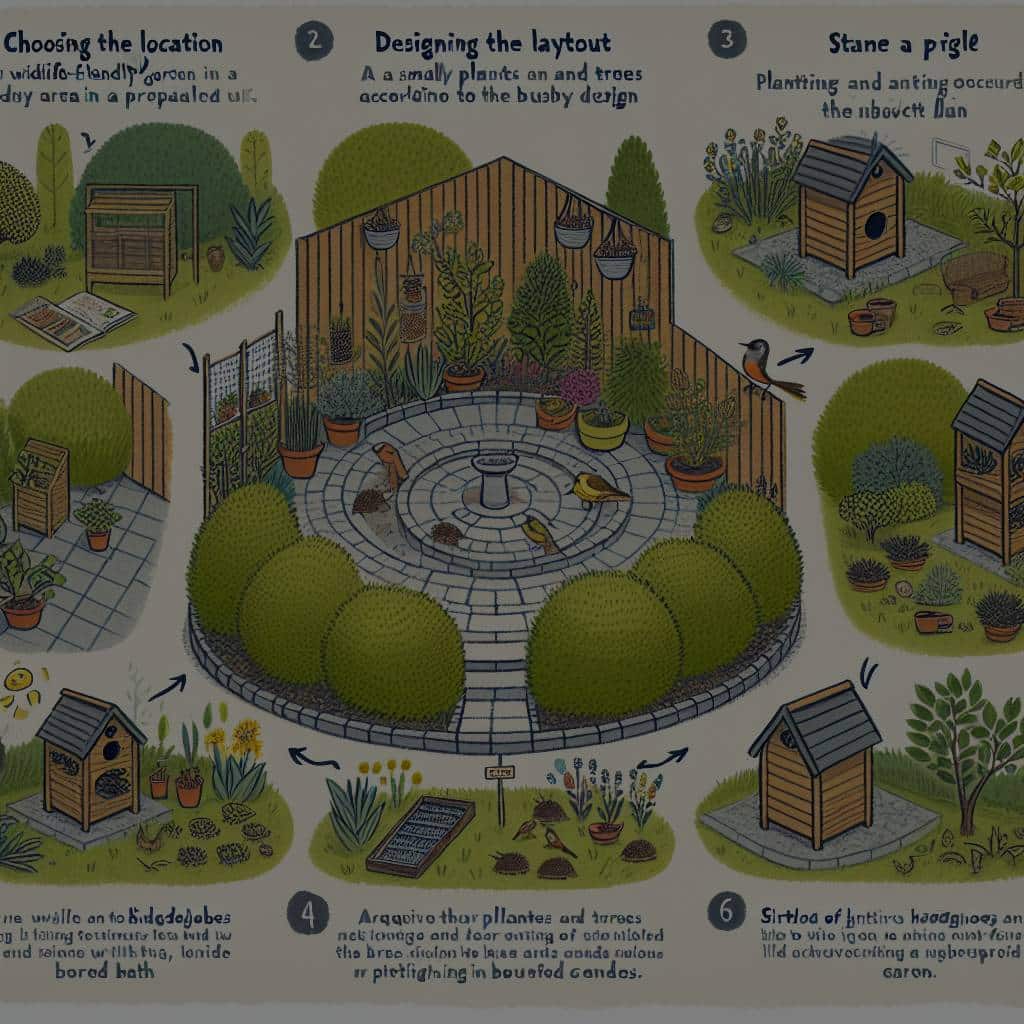What Are the Steps to Creating a Wildlife-Friendly Garden in Urban UK Areas?

As urbanisation continues to expand in the UK, green spaces are becoming increasingly scarce. This loss of natural habitats has a significant impact on local wildlife, threatening their survival. But you can help combat this challenge simply by creating a wildlife-friendly garden. The thought may be daunting, but it doesn’t require a lot of space or resources. Even the smallest lawn can provide a haven for nature. This article will guide you through the essential steps of transforming your garden into a sanctuary for wildlife, while also benefiting from the joys of gardening.
Choosing the Right Plants
The first step in creating a wildlife-friendly garden is to select the appropriate plants. The right choices will help attract diverse species and provide them with both food and shelter.
A lire en complément : How Is AI Being Used to Combat Loneliness in the UK’s Elderly Population?
When choosing plants, consider those that are indigenous to the UK. Native plants are naturally adapted to the climate and soil conditions, making them easier to grow and maintain. They’re also more likely to attract and support local wildlife. Choose a variety of flowering plants to provide a continuous food source for insects like bees and butterflies.
Consider also incorporating plants that produce berries or seeds. These can serve as a food source for birds, especially during the winter months when other food sources are scarce.
A découvrir également : What’s the Latest in Adaptive Traffic Control Systems for UK’s Smart Cities?
Avoid using pesticides and chemical fertilisers. They can harm the beneficial insects and microorganisms in your garden. Instead, opt for organic methods of pest control and fertilisation.
Providing Water Sources
Water is a critical component of a wildlife-friendly garden. It’s not just for drinking; many creatures, including birds, insects, and amphibians, use water for bathing and breeding as well.
If space allows, consider installing a small pond. Ponds are fantastic for attracting a wide range of wildlife, including frogs, toads, and various species of aquatic insects.
Don’t worry if your garden is too small for a pond. Even a simple bird bath can provide a much-needed source of water. Make sure to keep it clean and filled at all times, especially during the hot summer months and freezing winter periods when water can be hard for wildlife to find.
Building Habitats
Providing shelter is another vital step in creating a wildlife-friendly garden. Different species require different types of habitats.
Bird boxes and bat boxes can be installed relatively easily and provide much-needed nesting sites. For smaller creatures, consider creating a log pile or a compost heap. These not only provide shelter for various insects but also help recycle organic waste.
Another option is to leave a portion of your garden wild. Long grass, nettles, and brambles provide excellent habitats for a variety of species, from insects to small mammals.
Encouraging Diversity
Diversity is key to a healthy ecosystem. The more diverse your garden, the more wildlife it will attract and support.
To encourage diversity, aim to provide a variety of habitats and food sources. Different species have different needs, so the more varied your garden, the more wildlife-friendly it will be.
Try to attract not just the cute and colourful wildlife but also the less appreciated ones. Remember, every creature, no matter how small or seemingly insignificant, plays a role in the ecosystem.
The Role of Gardening Practices
Your gardening practices can significantly affect the wildlife-friendliness of your garden. Here are some tips to help you create a nature-friendly environment:
- Use organic, peat-free compost: Peat extraction destroys habitats and contributes to climate change. Using peat-free compost helps protect these habitats and the wildlife they support.
- Recycle garden waste: Composting your garden waste not only reduces the amount of waste going to landfill but also creates a nutrient-rich compost that’s great for your plants.
- Minimise disturbance: Wildlife prefers undisturbed spaces. Try to minimise the amount of disturbance in your garden, especially during nesting and breeding seasons.
- Be patient: Creating a wildlife-friendly garden is not an overnight process. It takes time for wildlife to discover and start using your garden. But once they do, the rewards are well worth the wait.
Remember, creating a wildlife-friendly garden is not just about the wildlife. It’s also about you. Gardening is a therapeutic activity that brings numerous health benefits, both physical and mental. It’s a way to reconnect with nature and contribute to the preservation of local wildlife. So, go ahead, start creating your wildlife-friendly garden today. It’s time to invite nature back into your urban life.
Creating Wildlife Highways
While the individual steps to creating a wildlife-friendly garden are vital, it’s equally important to consider your garden as part of a larger network of habitats. The creation of wildlife highways can help animals move safely between these habitats, improving their chances of survival in urban areas.
Some wildlife, like hedgehogs, need to roam across several gardens in search of food and shelter. However, modern fences and walls often block their paths, confining them to one garden and limiting their access to resources. To rectify this, consider creating small gaps at the bottom of your fences. These "wildlife corridors" will allow small mammals like hedgehogs and frogs to move freely between gardens.
Another element of wildlife highways is connectivity. Plant climbers like ivy or honeysuckle against fences and walls, as this can create vertical highways for insects and climbing animals like garden spiders and squirrels.
Also, be aware of the importance of overhanging trees and shrubs. They act as aerial highways for birds and bats. Keeping a few trees pruned but not cut back entirely can help maintain these vital connections.
Installing Feeding Stations
Feeding stations can play a crucial role in a wildlife-friendly garden by providing a reliable food source for garden wildlife. They can be particularly useful during the winter, when natural food sources may be scarce.
For birds, install bird feeders filled with a range of seeds, nuts, and fat balls. Different bird species prefer different types of food, so providing a variety will attract a broader range of birds to your garden.
Another simple feeding station is a bee hotel. These are easy to make at home or buy ready-made and provide a safe place for solitary bees to lay their eggs. Also, consider a butterfly feeder, filled with a sugar-water solution that mimics nectar.
For larger mammals like hedgehogs, a shallow dish of cat or dog food can provide a much-needed meal. However, remember to keep any feeding stations clean to prevent the spread of disease.
It’s worth noting that while feeding stations can help support local wildlife, they should complement, not replace, the natural food sources provided by your garden’s plants.
Conclusion: The Joy of Wildlife Gardening
Creating a wildlife-friendly garden is a fulfilling and rewarding pursuit. By following these steps, you’re not only creating an oasis for local wildlife but also contributing to wider conservation efforts. It’s an opportunity to learn about the fascinating creatures that share our urban spaces, from the smallest insect to the most colourful bird.
But wildlife gardening isn’t just about conservation; it’s also about taking pleasure in nature. It’s about the thrill of spotting a visiting bird species for the first time, the joy of seeing a butterfly emerge from its chrysalis, or the simple satisfaction of knowing that your garden is a small sanctuary for British wildlife.
Moreover, it’s about embracing a slower, more mindful approach to gardening. It’s about observing, understanding, and nurturing the nature that exists in our own backyards. In that sense, creating a wildlife-friendly garden is as much about cultivating a deeper connection with the natural world as it is about garden design.
So why not begin your wildlife gardening journey today? Whether it’s planting native plants, installing a bird box, or simply leaving a patch of your garden to grow wild, every step you take makes a meaningful difference. And as you watch your garden come to life with bees, butterflies, birds, and other creatures, you’ll soon discover the unique joy and fulfilment that comes with creating a wildlife-friendly garden.
